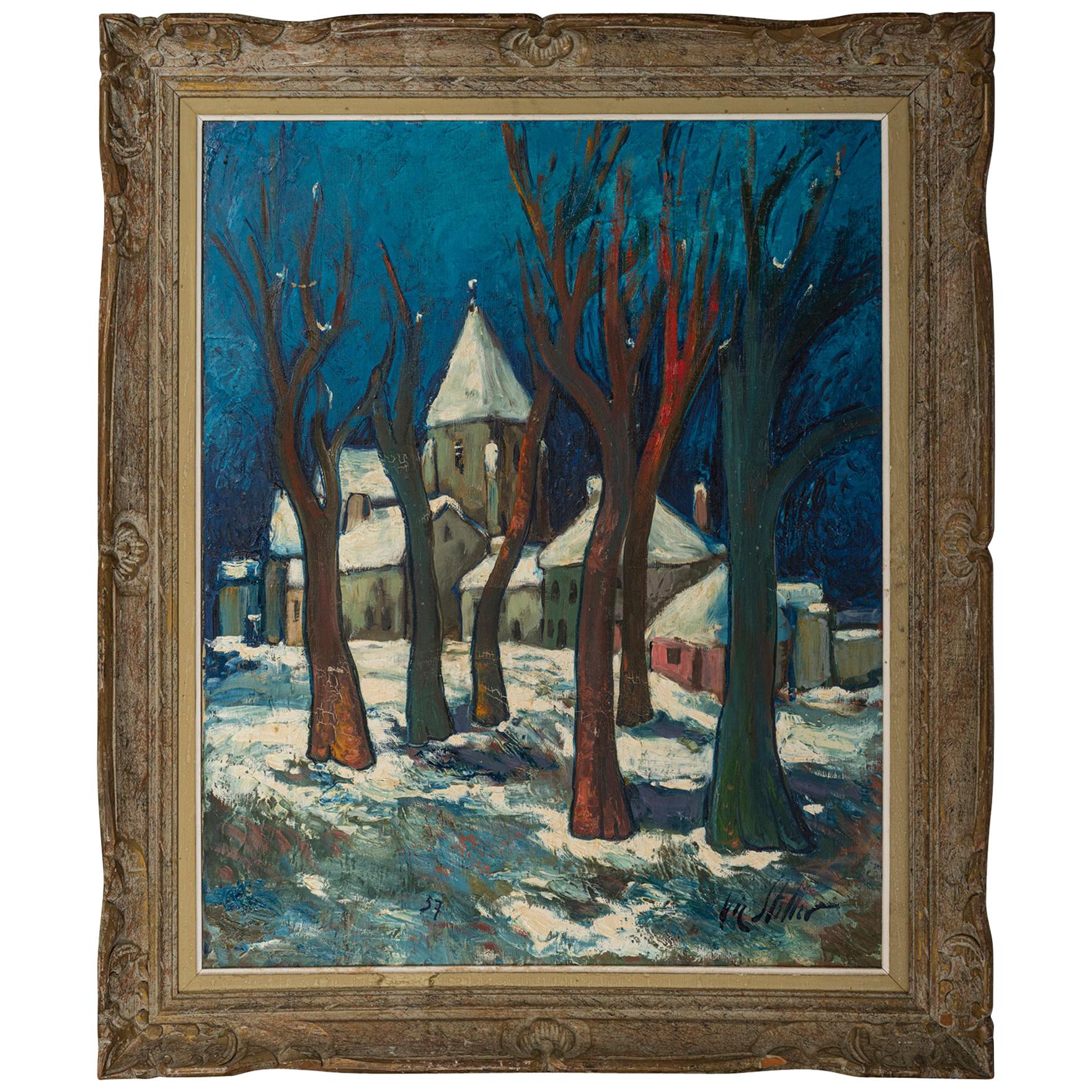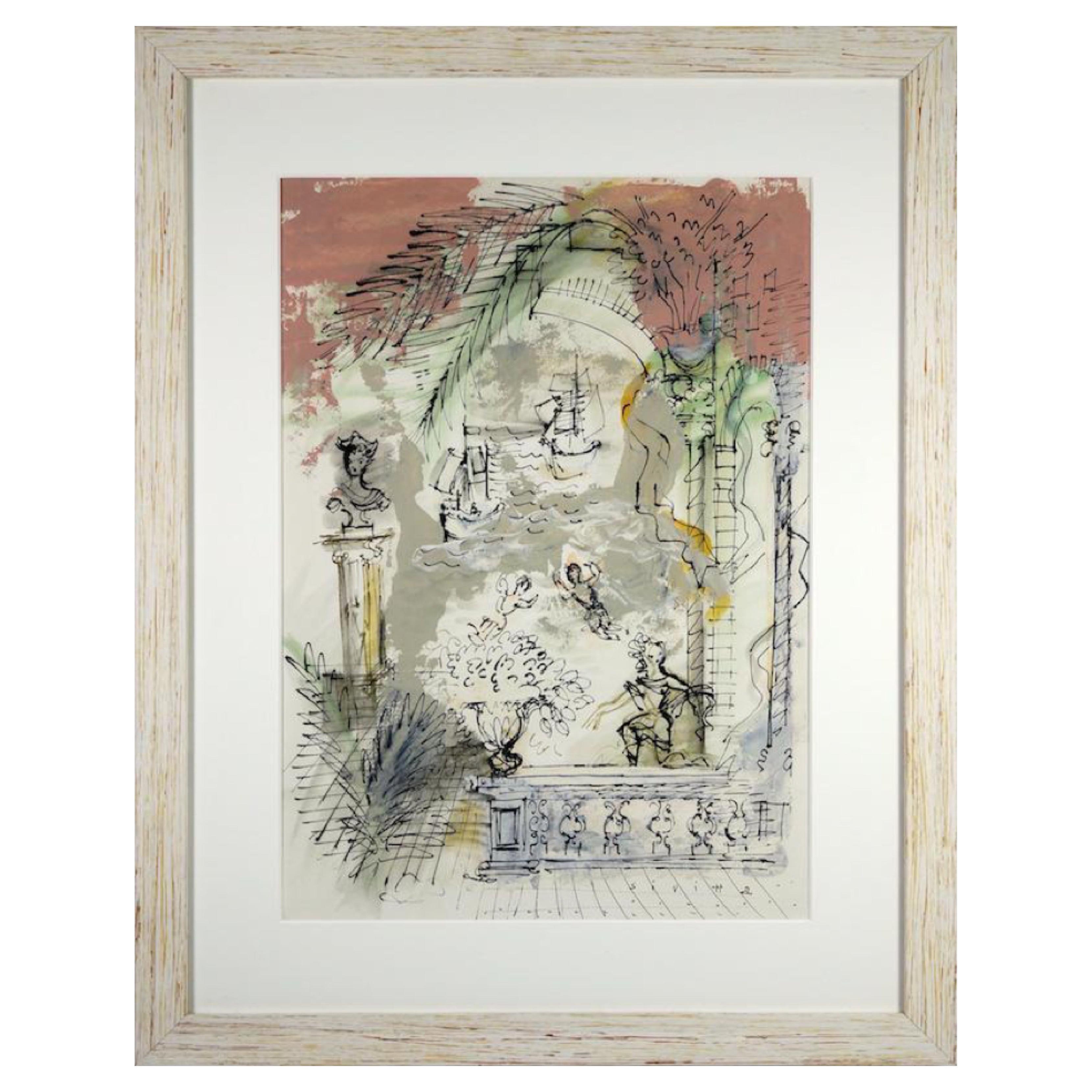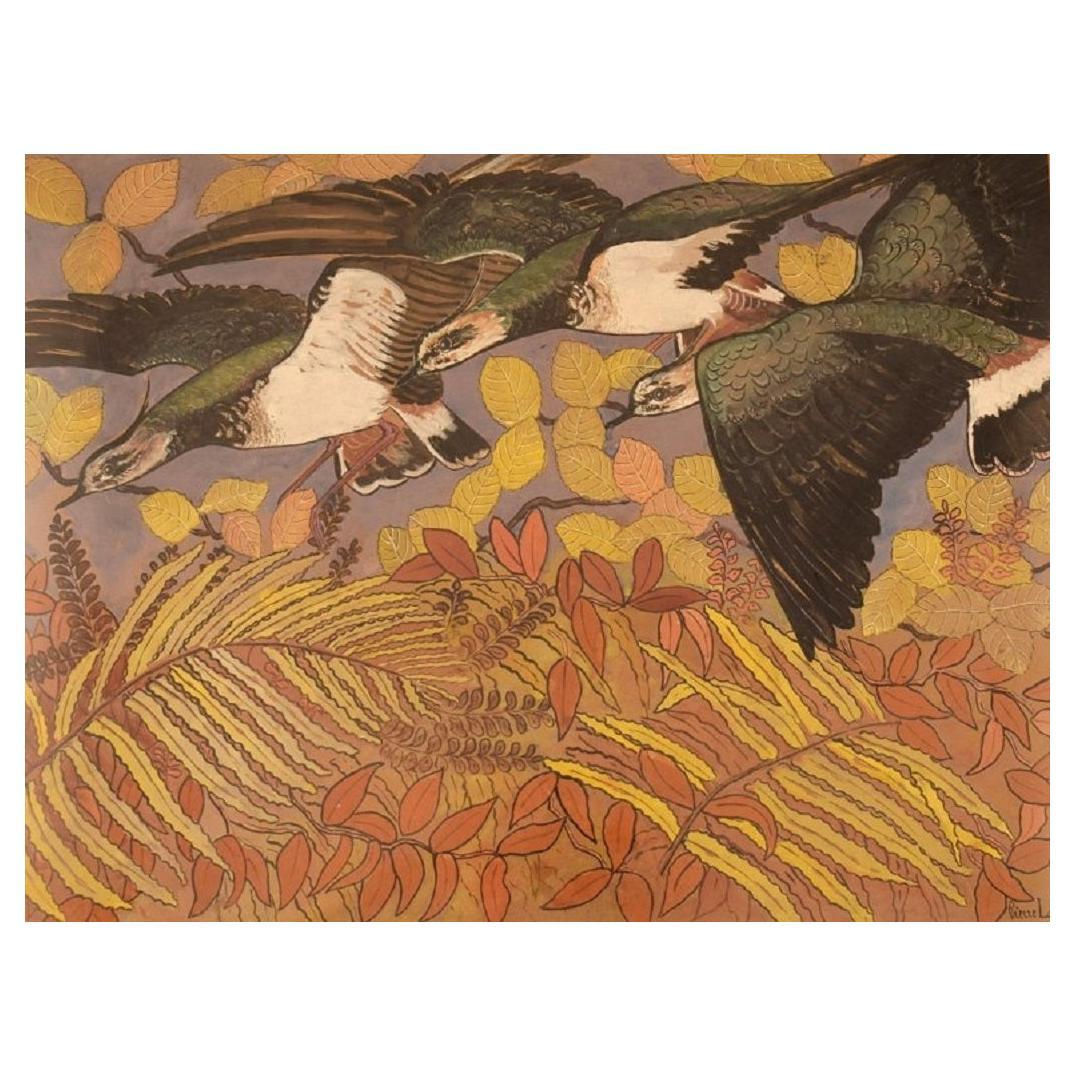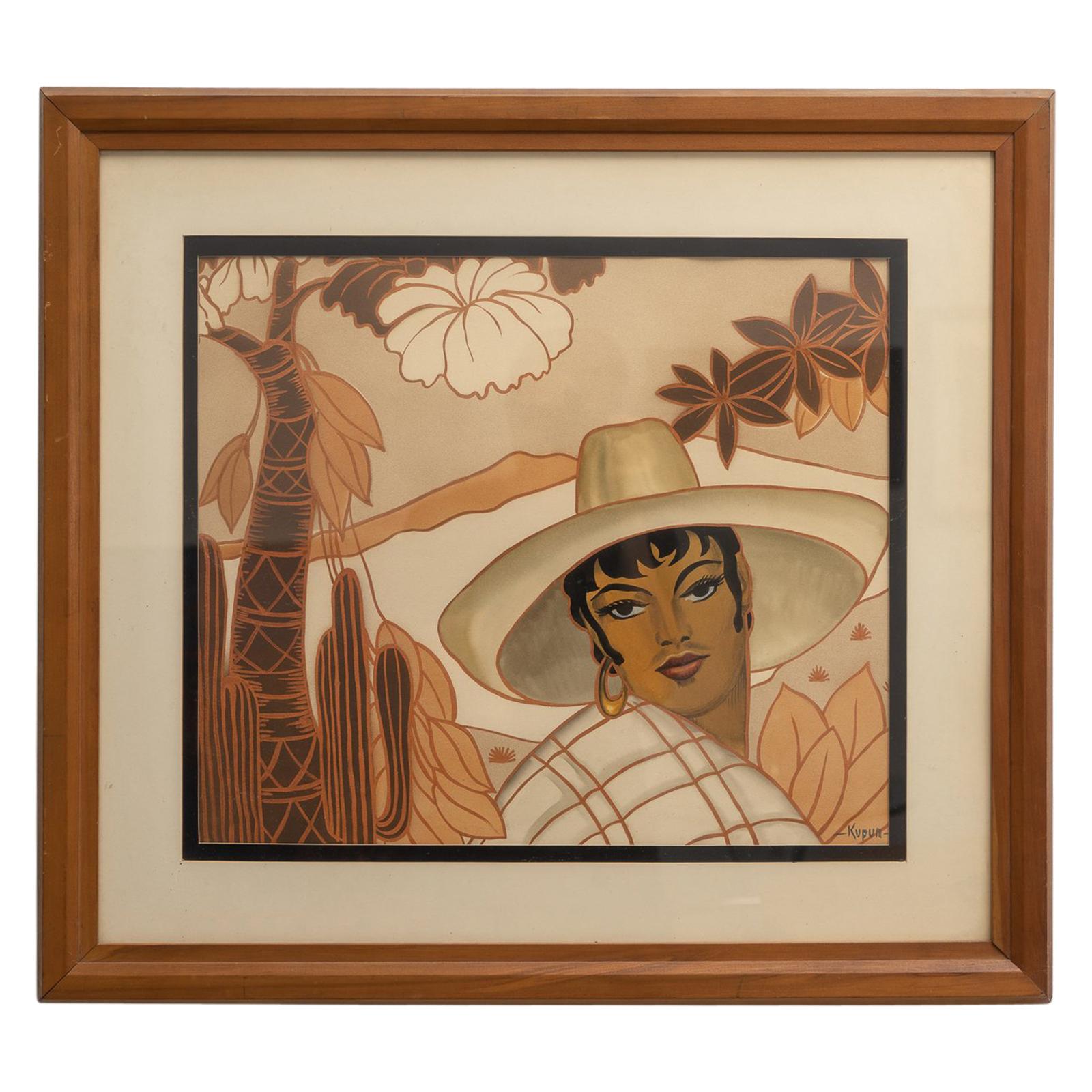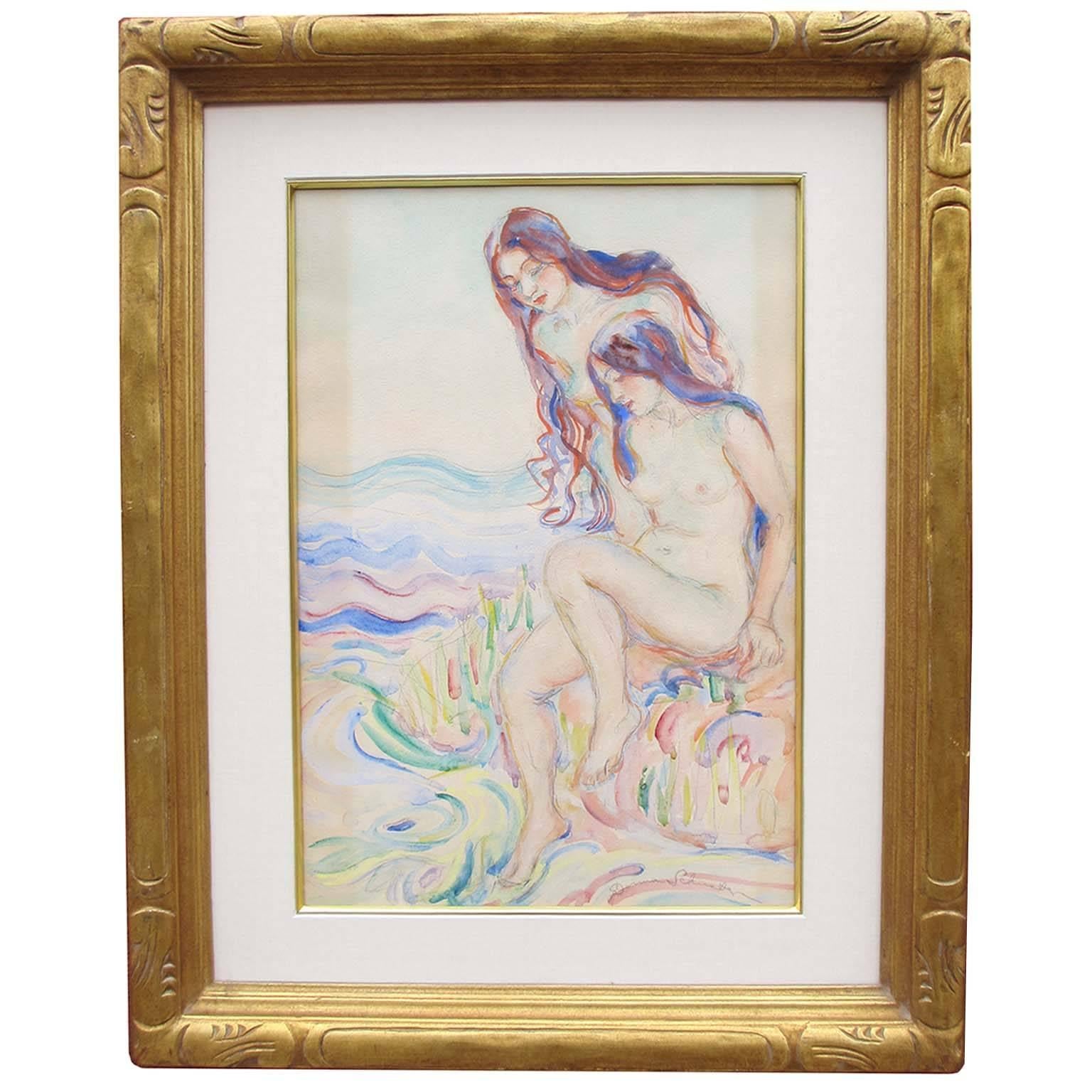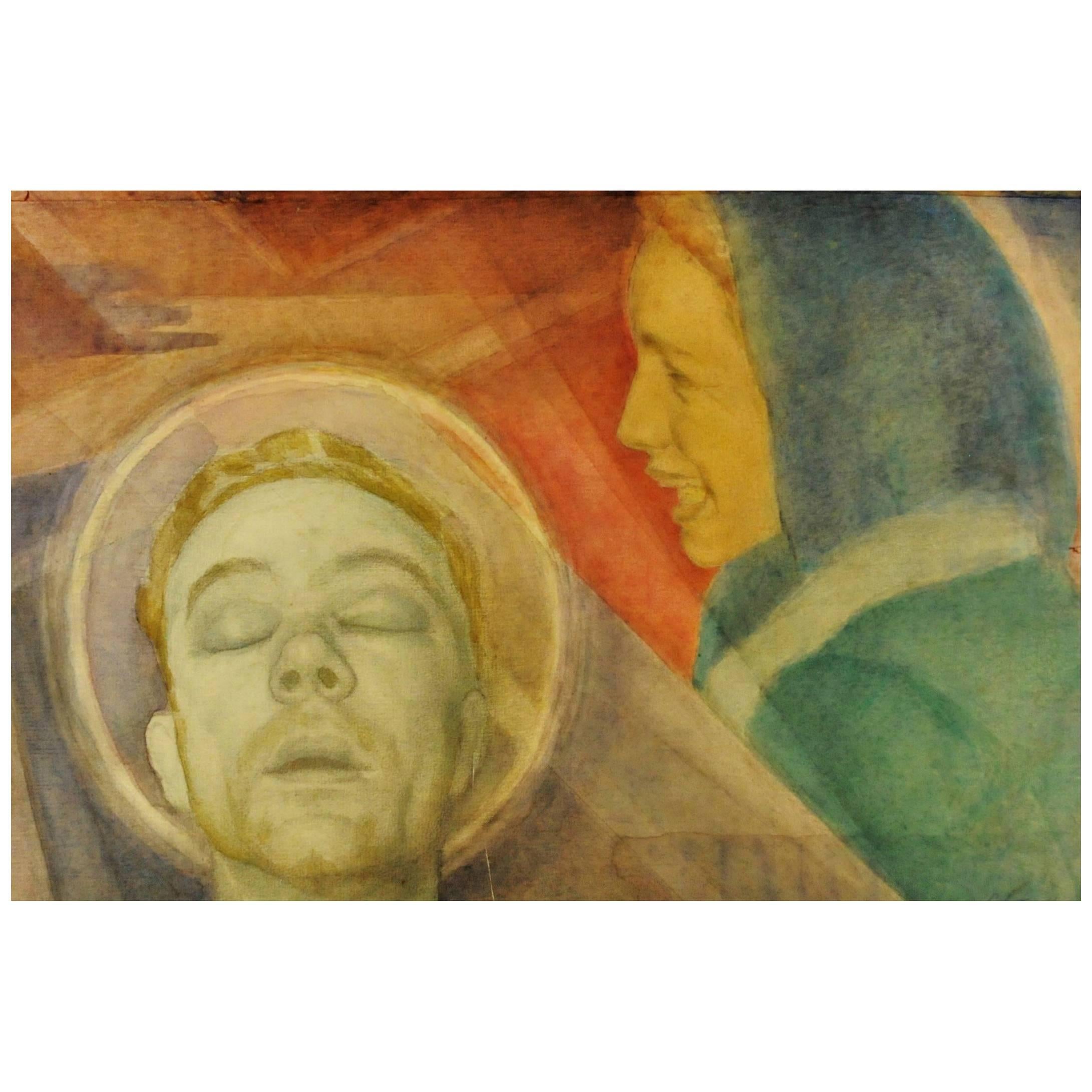Items Similar to Girl and Bird, Original Watercolor, Gouache and Pencil on Paper, 1960s
Want more images or videos?
Request additional images or videos from the seller
1 of 7
Girl and Bird, Original Watercolor, Gouache and Pencil on Paper, 1960s
About the Item
A wonderful work of Mid-Century Modern art, framed.
Artist’s signature is illegible
Dimensions:
Painting (only): 25 x 19.75 inches
Painting (framed): 26 x 20.75 inches.
- Dimensions:Height: 26 in (66.04 cm)Width: 20.75 in (52.71 cm)Depth: 1 in (2.54 cm)
- Style:Mid-Century Modern (Of the Period)
- Materials and Techniques:
- Place of Origin:
- Period:
- Date of Manufacture:1960s
- Condition:Wear consistent with age and use. We make our best effort to provide a fair and descriptive condition report. Please examine the photos attentively. Send us a message to request more details or discuss price.
- Seller Location:New York, NY
- Reference Number:1stDibs: LU2819315718921
About the Seller
5.0
Vetted Seller
These experienced sellers undergo a comprehensive evaluation by our team of in-house experts.
Established in 1993
1stDibs seller since 2017
68 sales on 1stDibs
Typical response time: 2 hours
- ShippingRetrieving quote...Ships From: New York, NY
- Return PolicyA return for this item may be initiated within 10 days of delivery.
More From This SellerView All
- Boris Solotareff, Double-Portrait, Watercolor and Gouache on Paper, 1920sBy Boris SolotareffLocated in New York, NYBoris Solotareff (Russian, 1889-1966) was a Russian painter, who was active in Switzerland and France; but spent the majority of his career in New York City, where he became a natura...Category
Vintage 1920s French Art Deco Paintings
MaterialsPaint
- Irina Shtenberg, Portrait of a Young Woman, Watercolor on Paper, circa 1940sLocated in New York, NYUnsigned. Attributed to Irina Valeryanovna Shtenberg. Period frame. Dimensions (unframed): Height: 13”, width: 11” Dimensions (framed): Height: 15”, width: 12-7/8” All the w...Category
Vintage 1940s Russian Mid-Century Modern Paintings
MaterialsPaper
- Johann Berthelsen, Manhattan Snow Storm Scene, Oil on Canvas Painting, 1960sLocated in New York, NYThis wonderful romantic painting depicts figures bustling along a Manhattan street during a snowstorm. Signed lower right. Johann Henrik Carl Berthelsen (1883–1972) Coming to America as a child, he enjoyed early success as an opera singer and music teacher. His friendship with the artist Wayman Adams resulted in a move to New York and experimentation with painting. When the great depression took a toll on his musical career, Berthelsen began selling oil scenes of his beloved New York City, which quickly found prominent buyers including William Randolph Hearst...Category
Vintage 1950s American Mid-Century Modern Paintings
MaterialsCanvas
- Bernard Taurelle, Nu, French Modernist Oil on Canvas Painting, circa 1960sBy Bernard TaurelleLocated in New York, NYSigned lower right corner. Stamped en verso Galerie Felix Vercel Paris - New York. Original period frame. Bernard Taurelle (French, B. 1931) is a famous French artist, widely known ...Category
Vintage 1960s French Post-Modern Paintings
MaterialsCanvas
- Spanish Colonial, Madonna and Child, Original Oil on Wood Painting, XVIII CLocated in New York, NYSpanish Colonial Madonna and Child Original oil on wood painting XVIII century DETAILS Original period frame. PAINTING DIMENSIONS Height: 6-3/8 inches Width: 7.5 inches Depth:...Category
Antique 18th Century Mexican Spanish Colonial Paintings
MaterialsWood
- Rolph Scarlett, Modernist Abstract Composition, Guache on Paper, Ca. 1950’sBy Rolph ScarlettLocated in New York, NYArtist: Rolph Scarletti (Canadian, 1889 – 1984) Object: Modernist Abstract Composition Period: Ca. 1950’s Medium: Guache on paper, framed Dimensions (unframed): Height: 9-1/3” Width: 12” Dimensions (framed): Height: 22-3/4”” Width: 25-3/4” Rolph Scarlett (Canadian, 1889 – 1984) was a consummate explorer of twentieth-century abstract painting. Never afraid of trying new styles, curious and opinionated, constantly engaged with the world around him while steadfastly aware that he was on his own path and his alone, Scarlett more than once proved to be at the artistic zeitgeist of the eras in which he lived. Exposed very early on to the work of Paul Klee through a chance meeting in Europe with the artist himself, Scarlett took up abstraction with a fervor that never diminished during his long and impressive career. To create something that had never existed before: this was Scarlett’s great cause. And that is what is most obvious when you look at Scarlett’s work—you have never seen anything quite like it. Scarlett was Canadian-born, came of age in the Midwest, and spent few important years in Hollywood, where he designed stage sets. His work from this early period echoes Klee’s use of color, his confidence in naïve, primitive forms, and his blend of abstraction and figuration. In its flat spatial qualities it prefigures the Indian Space painting of the 1940s by a decade. He moved to New York in 1933 and eventually found his first great patron at the Museum of Non-Objective Painting, directed by Baroness Hilla Rebay and art patron Solomon R. Guggenheim. Guggenheim would collect over 60 works by Scarlett for his collection, more than any other artist outside of Vasily Kandinsky and Rudolf Bauer. As a frequent exhibitor and lecturer at the Museum of Non-Objective Painting (MNOP), Scarlett honed his sensitive feel for bodies in space and capitalized on his trademark use of bright, vivacious colors into accomplished, perfectly harmonized geometric works. However, Scarlett soon morphed these hard-edged forms into a nuanced expressionistic abstraction which, at its best, seems to be populated by dancing forms that animate the canvases. Along this way he was advised by Rudolf Bauer, the German expatriate and one of the originators of non-objective painting in the teens. Bauer had the idea for the Museum, and Rebay, his champion, had found in Solomon Guggenheim a patron for manifesting it. When Bauer emigrated just before World War II, he wanted to meet Scarlett. The two became friends, and Bauer advised Scarlett on his work over the course of many years. Even in a 1979 interview, Scarlett began to tear up as he recalled his first meeting with Bauer, a man whose work he "worshipped," describing that, "It was a touching moment for me, I’ll tell you." Scarlett and Rebay also had a close, important relationship, one in which he bore the brunt of her sometimes condescending, if motherly, critiques and admonitions with tolerance and gratefulness. Eventually, though, he had to push back. In a letter from 1951 he writes, "I have noticed with growing amazement that during the past three years you have accepted less and less of my work—and, that same work, which you rejected has been accepted and shown in the best and largest shows all over this country." This period—the late 1940s to the early 1950s—did in fact correspond to Scarlett’s most critical success, and to a return to the fanciful forms and characters of his pre-war work. At the same time, he found his own rhythm and complexity using a drip style similar to, though denser and more opaque than, the one made famous by Jackson Pollock, who had worked for many years at the MNOP and with whom he shared common influences. In 1949 he had a very well received solo show in 1949 at the Jacques Seligmann Gallery, reviewed very favorably in The New York Times: "The impression made by these paintings is one of originality and strength." He was also included in a juried show "American Painting Today" at the Metropolitan Museum of Art in 1950 and in the Whitney Annual of 1951. The curator for the Whitney show in fact bypassed a selection of Scarlett’s careful geometrics in favor of a new "lyrical" drip painting—one which he describes as having had "a helluva good time" making. Rebay articulated her loss of control over Scarlett very keenly in one of her last official letters to him: "So your way ended in the horrid jungle it is in now; even a Mr. Pollock’s smearage was not bad enough for you to have a try at; and betraying yourself, you betrayed art and my faith in you, and my present disgrace by my failure to foresee such an outrageous possibility—since you even paint objectively now." Yet, despite the fact that he was moving in his own direction when the change in leadership took place at the Museum of Non-Objective Painting and Rebay was forced out as director, Scarlett was hit hard. He understood this change rightly as a betrayal by the establishment. Scarlett was a unique individual and soul, and was affected personally and philosophically by the idea that the movement with which Scarlett had aligned his talents seemed to disappear overnight, and his life’s work rendered valueless. Without the Museum’s support, Scarlett decided eventually to move to the artists’ community of Shady, New York, just outside of Woodstock. He had occasional shows throughout the years, but mostly settled down to regional obscurity. He began making jewelry, which had been his first trade, and it was following a show of his jewelry in 1975 at the Jaro Gallery, that he was rediscovered by Samuel Esses, and his wife Sandy. Samuel Esses was a successful businessman and an avid collector. He always sought out that which was unusual and, like Scarlett, was ahead of his time in many ways. For example, in 1979, Sam became enthralled with the early graffiti appearing on the New York subway trains. With the sole goal of preserving these groundbreaking yet short lived works of art he was inspired to create "The Esses Studio," a painting warehouse and workshop for graffiti artists to work in a studio, collaborate, and paint on canvas. The biggest names of graffiti writing participated—Futura, Crash, Dondi, Zephyr, and Daze to name a few. The project was well received and provided critical validation at an important time for this alternative form of abstraction to be recognized by the established art world. The success of the "Esses Studio" helped fuel an alternative fire that would propel gallerists and curators to acknowledge other street artists and provide a foundation of acceptance for the early careers of Keith Haring and Jean-Michel Basquiat. It is not a stretch to say that what Esses saw in the graffiti art of the 1970s was very similar to what he saw in 1950s-era Scarletts—something raw, honest, and melding many twentieth century influences into one unique form. Inspired by the importance of the collection and the passion of the collector, Weinstein Gallery...Category
Vintage 1950s Canadian Mid-Century Modern Paintings
MaterialsPaper
You May Also Like
- "Cherubs" Gouache and Watercolor on PaperLocated in West Palm Beach, FLContinental school, 19th-20th century "Cherubs" Gouache and Watercolor on paper Size with frame: 19 x 11 in. (48.26 x 27.94 cm.)Category
Vintage 1950s Drawings
MaterialsPaper
- 1960s Raoul Dufy Venice Gouache on PaperBy Raoul DufyLocated in Los Angeles, CARaoul Dufy "Venice" gouache on paper. Nice new wood frame included. Framed size: 26" x 33" Image size: 16.5" x 23.5".Category
Vintage 1960s French Modern Paintings
MaterialsWood, Paper
- Pierre Lacroix, Watercolor on Paper, Birds and FoliageLocated in Copenhagen, DKPierre Lacroix (1912-1994), a listed French artist. Watercolor on paper. Birds and foliage. 1960s. Visible dimensions: 64 x 48 cm. Total dimensions: 76 x 60 cm. The frame measur...Category
Vintage 1960s French Paintings
MaterialsOther
- Gouache on PaperLocated in West Palm Beach, FLThis stylish and chic 1930s gouache on paper by Kapur depicts a "Latin Lover" in all of his glory as he is surrounded by a lush, tropical garden as he...Category
Mid-20th Century Argentine Mid-Century Modern Paintings
MaterialsPaper
- Donna Schuster “Nude Bathers” Watercolor, Pencil and GouacheBy Donna N. Schuster 1Located in Los Angeles, CADonna Schuster (1893-1953) “Nude Bathers” watercolor, pencil and gouache within a giltwood carved frame and protective glass. Signed ‘Donna Schuster’ (Lower Right), circa 1920-1930. ...Category
20th Century American American Classical Paintings
MaterialsGlass, Wood
- Donna Schuster “Mother and Child” Watercolor, Pencil and GouacheBy Donna N. Schuster 1Located in Los Angeles, CADonna schuster (1883-1953) “Mother and Child” watercolor, pencil and gouache within a giltwood carved frame and protective glass. Signed ‘Donna Schuster’ (Lower Right), circa 1920-19...Category
20th Century American American Classical Paintings
MaterialsGlass, Wood
Recently Viewed
View AllMore Ways To Browse
Vintage Bird Wall Paper
Vintage Bird Girl
Used Furniture Orange County
Small 19th Century Landscapes Oil Painting
James River Furniture
Deco Oil Light
Vintage Union National Furniture
Painting Mystery Artist
Fruit Paintings Pair
Spanish Frame 17th Century
3 D Wall Panel
Holy Virgin
Vintage Woodland Furniture
Antique Horse Wall Art
Serenity Wall Light
The Holy Virgin
Painted Chinese Wall Decoration Panel
Retro Furniture Portland
